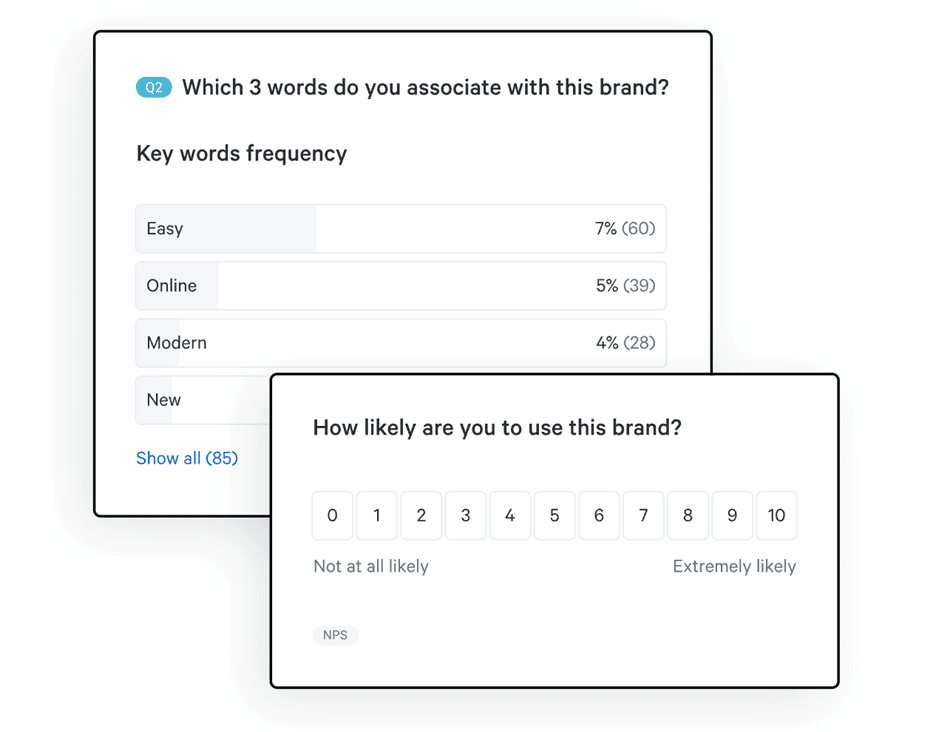As a modern-day society, we’re overloaded with information both online and offline. Whether that’s paid-for, featured adverts to flyers posted through the mailbox, we receive it whether we asked for it - or not.
It’s pretty overwhelming often enough, which is why it is difficult for businesses to get noticed in the first place.
It typically takes around 5-7 brand interactions before a consumer even remembers the brand. Branding plays a critical role for any business, that’s looking to level up its site presence, and brand awareness in general.
For both new and established businesses, a branding strategy should be in place to help grab your audience’s attention.
In this guide, you’ll get a better understanding of what branding is, and the formats it typically comes in. We’ll also share some key insights into branding and the influences it has on a business.
By the end of the article, you’ll have a better idea of how branding works and its benefits for your business this year and beyond.
What is branding?

To give you our version of ‘branding for dummies’, brand is a type of marketing concept in its simplest description.
Unless you’re cut off from civilization, branding is everywhere. Branding comes in different formats; a design, a name, symbol. Anything that identifies the seller of the goods or service being advertised, or provided to the consumer.
Branding evokes both a physical and emotional reaction, which is important for capturing the attention of any potential customer.
It takes 20 years to build a reputation and five minutes to ruin it. If you think about that, you’ll do things differently.
- Warren Buffett
Think about some of the most familiar, world-renowned brands like Apple for instance. You see the iconic apple logo and most of us nowadays will immediately connect it to the iPhone, or one of Apple’s other electronic products.
With so many businesses on the market, it is very easy to copy a product. However, branding is always a unique element that makes a big impact. The approach to branding is often linked directly to the type of audience the business attracts.
For example, a logistic company like Fedex uses purple as its main color palette throughout its branding.
FedEx has a more professional air to it. Since purple is so uncommon in nature, it serves as the lone accent in their otherwise monochrome color scheme, contributing to the palette's inorganic, corporate vibe (some folks even claim that purple is an artificial color).
Key branding statistics worth knowing.
Branding is required whether you operate as a business online, offline, or in a hybrid capacity.
As a consumer, approaching a business for the first time is the best opportunity to earn their trust. With 48% of people claiming that the first interaction or purchase is the best time for earning loyalty, a company’s branding should hit the mark straight away.
Keeping customers is notoriously harder than acquiring them, especially when your competitors are actively looking to snatch them from you. That’s why any branding as a business, needs to remain consistent. It’s important to create branding that you’re happy to stick with for the long run.
Few businesses will change their branding in their lifetime. To do so runs the risk of losing customers, and recognition of the company online and offline.
Many businesses forget that branding extends to more than just the physical and visual experiences. It has also been shown through a company’s quality of customer service. U.S brands are losing around $41 billion each year due to poor customer service. That’s a hefty price tag.
Considering live chat services and automated technology are readily available, it’s hard to understand why some companies fail to utilize them for customer support.
10 reasons why branding is important
If you’ve got this far in the article, great - you’re about to get to the juicy part. We’ve explained what branding is and the statistics on how it’s proven beneficial, but why do it?
Your business wants to jump straight into advertising and marketing to make a quick sale. However, branding plays a big part in your marketing strategy. If the branding doesn’t look right, no matter what type of advertising you put out, it’s not going to achieve the intentions put out there.
We’ve got ten reasons why branding is important for any business in today’s market. Put on those brakes and understand why branding is beneficial before you go about improving it.
1. It benefits to know your customer’s brand perception.
Could you hand on heart, say what your customer thinks of your brand? What is their perception of your brand? Businesses aimlessly navigate through their marketing efforts and find that the branding that they have is doing nothing for them.
For customers, brand perception is the difference between them talking good…or talking bad about you. With word-of-mouth more effective than paid ads, resulting in five times more sales, it also causes the opposite to happen.
Brand perception has a noticeable impact on all aspects of your customer’s interactions with your business. From customer loyalty to boosting sales and lowering acquisition costs, they’re all influenced.
If you’re looking to learn more about brand perception, then utilizing resources online is a good place to begin your exploration of this.
With poor brand perception, it’s hard to shift that negative attitude towards your company. The linked resource above offers actionable changes to make to your business branding, to help bolster a customer’s perception of your brand.
2. Distinguishes the company’s products from its competitors.

There’s no denying that competition is fierce for any business. The internet has managed to create an army of new businesses that are transforming business as we know it. It means that older companies need to pull up their pants in order to keep up with the change.
Branding is a big help in distinguishing the company’s products from those competitors who are providing similar products/services.
Defining one’s unique selling proposition, otherwise known as USP, is important to help stand out. When the noise of competitors is loud, you have to be louder.
Let’s look at it from this point of view. If you’re selling a bicycle, how is that bike distinguishable from the hundreds of other bike brands on the market?
If your answer is, it’s not - then your branding must change. What are some things that distinguish your products or services? Here are some examples:
- Offering unbeatable customer service.
- The pricing of your products.
- A specific logo or color palette.
- Unique features not found anywhere else.
When you distinguish your products through the use of branding, it helps them stand out from the crowd. That leads to more customers noticing your product, buying it, and repurchasing it.
3. Branding is great for improving customer loyalty and trust.
As a consumer, browsing branded products evokes an emotional response. The type of colors used to influence mood, the font, and the imagery are all influential to what they choose to pick up or put down.
Sustaining a business is done so through its customers and the more you hold onto and retain, the better. Branding, as we’ve mentioned is impactful when it comes to customer retention. More importantly, it influences how likely they are to return to buy again.
That’s why consistency is key when it comes to branding. The emotional bond is one you want to continue between your products and your customers. It’s what helps build trust and ultimately, loyalty to your business as a whole.
By gaining more customers who are loyal to your brand, you end up spending a lot less on your acquisition costs. Saving time, effort, and money is only going to benefit the business further down the line.
Branding keeps your business relevant.
In a world full of changing trends and algorithms, a brand very quickly become irrelevant. With that in mind, it’s important to be aware of the relevancy of your own business.
Some businesses that have been around for decades, still need to keep up with their branding efforts to stay relevant amongst newer businesses.
It’s why social media has become such a powerhouse for businesses to promote their products or services regularly. Again, consistency matters and the more acquainted a customer becomes with a brand, the more activity your business gets.

As a business, you never know what will happen from one day to the next. You could garner overnight success with a viral Tiktok video and then plummet to the bottom of the commercial trash bin due to a backlash of negativity on a new product.
Relevancy is also why you should be active both online and offline. A simple case in point is COVID-19, where in-person interactions were simply not allowed or limited in their frequency.
With online businesses moving over to the internet, it became a sink or swim situation for everyone who found themselves in the same boat.
5.It helps track performance.
For brand awareness, analysis and data-tracking are key. It’s why so many businesses will often have analytical software in place, to check on the performance of their marketing efforts.
Popular platforms like Hootsuite are useful in reporting back to marketing teams on how their business efforts are doing.
In relation to branding, those businesses that have a clear brand image and purpose are those that are likely to see the best results.
Diving into business insights is helpful to see what’s hitting the mark for customers and what’s missing it.
The type of branded content you put on a social media profile has a bigger impact than an image that doesn’t feature the brand at all.
It’s important to remember that as well as your existing customers, you will also be reaching potential leads too. Introducing the branding from the get-go is likely going to help get those leads down the buying funnel quicker.
A dip in performance will often encourage a business to look at what’s lacking, whether it’s poor customer service or product imagery that isn’t showcasing the company branding enough.
6. It entices top talent to the table.
Employees are a considerable influence on the success of your business. By having the top talent working for your company, you give it a boost that puts you above everybody else.
A positive reputation and a large one at that, is going to help draw in the talent that your company is looking for now or in the future.
Any graduates fresh out of university or college will likely drift towards those businesses that are making an impact, either online, offline, or both.
A good brand image often translates as being a financially stable option for anyone looking for a new job. It all boils down to trust, just like your customers require it, so do your employees.
Not only does it help entice them, but it also encourages them to be on your side when it comes to working hard and being productive. Your employees will be more likely to want to make an effort in pushing it further up the ladder of success.
7. With good branding, comes social influence.
Good branding is good for whatever parts of society you reach. Whether you are engaging with a local or national audience, to a global one, you become valuable to those you reach. Many businesses have managed to garner the success of becoming household names.
Companies like Amazon, Target, Hello Fresh, and Peloton, have all individually developed great success through branding. As a business, when you achieve this level of value, it often makes your opinion valid and impressionable.
If you have no reputation whatsoever, then customers aren’t going to look twice at you. It puts all your good efforts to waste and so it’s necessary to spend time on branding.
Spending time on it and remaining resilient with branding is how you achieve the same successes as these big brands have done already.
Building a brand takes time and isn’t something that is be achieved within a year. For some, it takes decades of hard work and persistence. Very few will achieve it in a shorter space of time.
8. Makes it easier to promote your products.
With relevancy achieved and customers trusting your products, guess what? It becomes easier to promote and sell them. As a result of the easier promotion, you get the additional benefits of:
- Promotional budgets made more cost-efficient.
- Helps shift attention and priority to new and upcoming products.
- Greater chance of your products having immediate success.
Coming back to Apple as an example, it’s created a brand and notoriety where there’s extreme hype now whenever a new phone comes out.
While we’re all aware that the differences from one phone to the next aren’t revolutionary in their technology, everyone still wants the latest one available.
Not only have they created great products but they’ve communicated their branding in a consistent and effective manner. As a result, they now post content that doesn’t necessarily shout out what the brand is for newcomers.
Instead, they’re now showcasing the quality and performance of their products without actually showing their products for the most part. To get to that level of branding is god-like.
9. It becomes its own asset.
A brand in itself is an asset for a company. If you’ve managed to generate a brand that is instantly recognizable or has a certain degree of sway on the public, then it’s an asset that is used by others.
This is particularly helpful for those who are looking to pitch their business to other clients, perhaps suppliers for the product. By having a brand that’s also an asset, it helps to influence the sway you have when it comes to getting partnerships to sign on the dotted line.
It’s a huge part of your business and as a result, it brings more opportunities to the table, as well as making an impact on revenue.
10. Gives your business protection.

Finally, but certainly, by no means least, branding gives your business protection. For a business to last, it needs to validate and solidify itself within its own market. The extra bonus is when the brand has grown so much that it’s renowned throughout all business markets.
Without a brand that has a reputation, you allow other copycats and businesses to take from you without you being able to do much about it.
It is incredibly frustrating when this happens to small businesses by big corporations. However, when there’s very little risk of fallout, it’s natural for others to take advantage of others.
With branding in place that’s successful, companies will still copy you but the difference is that your style and originality won’t be stolen.
Top tips to improve your branding as a business
How do you improve your business with the knowledge you have now on branding? Let’s look at five top tips that help point you in the right direction when it comes to your own brand.
Conduct market research on branding
First and foremost - market research. It’s part and parcel of any business when it comes to discovering what works for the market and what doesn’t.
As a brand, you need to understand your target audience and what they look for when it comes to branding. Conducting a survey can provide you with valuable insights into consumer preferences and perceptions of your brand.
From the qualities, they look for when it comes to branding, to how aware they are currently of your own brand. This is all found out by conducting market research. This brings us back to the importance of brand perception, so don’t skip this step.
Improve your credibility as a business
As a business, credibility is important. Setting a good first impression is key and establishing that trust between you and the customer is going to help with brand awareness.
Look at the current credibility that your business has. How much do your customers care for your brand? Do they trust you enough?
There will always be improvements made to a reputation. Look at pain points that customers experience, in more detail. Identify what brand changes need to be made to give your company the step up it needs in credibility.
Incorporate SEO practices
SEO is a key player when it comes to brand awareness and providing your site with more exposure.
Providing a blog to go along with your website is a great way to provide more branded content. Adding in high-quality backlinks and on-page SEO all help with improving your chances of the the webpages ranking high.
A long-term branding strategy is going to incorporate a lot of things, including search engine optimization. If you want to stand out, you have to be willing to play game with Google’s indexing methods and algorithm.
Provide the best customer support services

Customer support services are essential and if you’re not providing the very best, then you need to. If you’re providing your customers with the best services, chances are they’re going to come back.
With 93% of customers likely to make repeat purchases with companies that offer excellent customer service, this should be the drive you need to make a change.
Customer experience is evolving. Adapting to this, through your company’s branding, is just one way that you help retain your customers and attract new ones.
Invest into your business branding
Branding is not optional, it’s mandatory for your business to succeed.
Without proper attention to detail in regards to your branding strategy, you’re setting the business up to fail. To get noticed and remain present on the market, is incredibly difficult. However, it’s totally achievable.
Invest into your business branding and what you’ll get from it is priceless in it’s value. You’ll be thanking your present self when garnering plenty of business success in the future.





